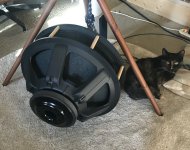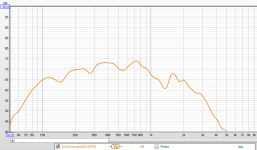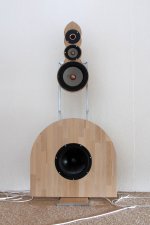Nearfield bass can be very good ....
Can near-field bass behind the listener be simplified with
1. mono for <100Hz ?
2. OB if in the extreme near-field eg <25cm ?
I was! 🙂A typical boxed speaker should have WAY more energy storage issues than an OB unless the OB uses a huge baffle and there are panel resonance issues. I get around that by using practically zero baffle!
Edit: Oh wait, I think you were referring to "El Pipe-O"!
This have been my experience too. I know I should not talk without showing measurements and I honestly tried to find them but with no success.OK, OK, I did not pull this info out of thin air... I made measurements in late 2021 of two 12" drivers at various separations to investigate just this situation. See this post and attached measurements:
https://www.diyaudio.com/community/...eless-full-range-speakers.374043/post-6729463
Also there are many posts and measurements by others scattered through that thread.
In my own measurements I found that very small separations of about 1" to 2" resulted in an SPL level that was about 3dB less than when the two drivers were separated by about 6" or more. The drivers were arranged face to face, so I am referring to the separation of the two mounting flanges. As you increase separation nulls appear in the response at increasingly lower frequency but the low frequency SPL is not changing. This tells me that you should use some minimum separation and that seemed to be about 4" to 6" in my case.
This was years ago when I did a lot of experiments for my first steps into OB, I focused on nude speakers for the look/simplicity/and ease on testing.
And I ended up with UM-15s in open-clamshell (for lack of better words), after maybe 20 sets.
The best response was with the width of my hand between them, a little more or less didn't change anything, but closer or too open did.
Also too much width would start to blur the sound if crossed higher. This could be fixed with dedicated dsp channels but I never tried (also there might be something to do here, to steer the sound to the front).
Now I don’t know what is really going on, even after reading on SL's analysis as it’s not exactly the same setup.
This configuration was sure better than two drivers stacked in vertical (always nude), in measurements and to my ears.
So maybe it’s just the floor coupling that is doubled.
But there might be something else in the side areas, like an expanded width of the null that has a bigger dipole effect.
Plus I really like:
- the compactness, allowing to move them around, closer to me, or change the axes of the nulls.
- the minimal visual clutter, especially since I used a tripod for the high section, they fit in.
- the ease of the build, well no more build
- the look, really love it, especially with the two ultimax it looked like some sort of energy pump/engine.
It was suprising to not see them moving/vibrating even with big excursions, they were very heavy compared to the cones mass.
I didn't suspend them but had some sorbothane bricks below at first, after a while the driver edges cut them to pieces so I just removed them.
Unless I went at very very high spl they were fine without any kind of suspension, but I had thick carpet below.
I also played with some curved wood covers and it looked even better, to my eyes.
Didn't have any effect on sound if not crossed too high. But yeah they would dance at insane spl.
Found a pic:

After a big move I restarted everything and picked more local drivers.
Bigger room needed bigger drivers, so went with the 18sw450, so cheap I had to try, and boy they are great.
Plus much more sensitive of course, they sound better than the UMs, I could let them play higher but ultimately picked 200Hz.
They are lighter than the UMs so right now I’m still searching for a good solution to decouple them more of the floor, that is concrete this time.
Tried few things with no success, I am searching for a big rubber ring, thick and rigid enough to hold them in place.
Maybe a dog ring toy if I find a sober one, not this 😛
For a while I didn't have subs and they were great but of course no ultimate deep bass, maybe good to 40-50hz, but a lot of impact and that's all I asked for.
Now with 2 subs they’re even better, freed of the very low stuff.

Once again with SL ... Performing some arithmetics with the data he left on his linkwitzlab.com site, we can make some dry swimming excercises.I have found that a baffle of 20x20 inches is large enough for bass response down to below 100Hz
Design for a studio monitor and taking your 20x20 inch baffle, fittting it with a typical 12-incher (Sd=500cm^3 and Xmax=12mm), and then placing it onto the floor, you can expect a SPL of 112dB at 90Hz. Which is perfectly fine for a studio monitoring use. If then complementing it with a sub as you do (and which gives the OB bass driver another 6dB headroom), the xover frequency can be lowered to 75Hz to stay inside the 112dB SPL target for the whole system. Instead, designing something less dynamic, as for a typical home system, along with the same baffle, same driver, but reducing the SPL goal to some more moderate 102dB, the values for the aformementionned frequencies shift down to 60Hz and 50Hz respectively.
Now, in DIY audio everything is rather personal preferences and subjective. For me, a 20-incher baffle seems already quite huge. Was there, done that ... So instead, taking the same driver, but naked or minimum-baffled, and hung a bit away from the floor, would shift these frequencies up to 140Hz and 120Hz respectively for the 112dB case. Does this make sense? Not really for me. I prefer a bit smaller drivers. E.g. something like a 10-incher in the picture, and for this calculation example again hanging a bit away from the floor. Using this 10-inch driver (Sd=360mm^2 and Xmax=9mm), the frequencies shift to 170Hz/150Hz for a 112dB goal. And as I am a conservative guy trying to minimize the distortion products, I like to design for a very cautios Xmax=2*(CoilHight-GapWidth)/3, which shifts everything up a bit once again for the same target SPL's.
So, at the end of the day, yes. You are absolutely right. A 20x20 inch baffle along with a decent driver will certainly provide quite an autoritative system. And as for you, you may cross to your 2*21er backticklers (I must admit that I envy you a bit for this project) at some 75Hz and even below. And I am also right. I might get happy with my teeny-weeny-OB-mini. And I would cross them at 150Hz to two minimumbass columns next to my ear. Only problem I would have then is to be constantly aware that I do not pour my audiosession cashew-nuts or drip my cigar ash onto/into the cupwise inviting cones.
Please note: I mentionned dry swimming. The calculated values are derived from the total volume displacement capacity (Sd * Xmax) of the driver only. Real-world you would also have to respect other parameters and values, such of the power handling capacity and Qts of the drivers.
Attachments
Last edited:
@Daihedz You wrote:
You can also consider that at the crossover frequency the response is already down -3 (for constant power type) to -6dB (constant voltage type) crossover filters, and this relaxes the Sd*Xmax displacement requirement there and within maybe 0.5-1 octave above the crossover point for the woofers that are being high-passed.Please note: I mentionned dry swimming. The calculated values are derived from the total volume displacement capacity (Sd * Xmax) of the driver only. Real-world you would also have to respect other parameters and values, such of the power handling capacity and Qts of the drivers.
Yes, this is an important precision and illustration. Thank you for this one. You are perfectly right. I would better have mentionned a range of downshift for the xover frequency for equal system spl. And I better would not have taken the theoretical minimum of the downshift without commenting this. My above downshift values figure the theoretical minimum at an max. theoretical overall 18dB/Oct slope: 6dB/Oct for the OB far-field (== the distance where the typical -6dB low-frequency slope of an OB is fully established) low frequency response, and 12dB/Oct for the theoretical max. slope of a magnetodynamic driverrelaxes the Sd*Xmax displacement requirement there and within maybe 0.5-1 octave above the crossover point for the woofers that are being high-passed
In real-world, depending on theirs fs and Qts, typical speakers will show a slope of around say 3 ... 9 dB/Oct around the frequency range of interest. Which translates into a total system slope (OB far field plus driver) maybe around 9dB/Oct ... 15dB/Oct for this frequency range, and therefore to more consistent xover frequency downshifts than the values I stated. And therefore, in the above example with the floorstanding baffle, a real-world downshift from 90Hz to say 65Hz ... 55Hz is much more realistic than to 75Hz.
One of the conclusions of this quite erratically theoretical quessing: This is why measurements are so important for implementing correct x-overs along with bass OB: Measure a bass OB very nearfield to the driver's (where there is no proper OB sloping effect yet) to measure the driver's own response, and then complement the measured data by including the expected far-field 6dB/Oct slope for the compound OB setup.
Last edited:
I use a 12" nude driver as lower mid, LR2 at 150 and 900Hz (varies with version) Here you can see the eq needed for straight response 100-2kHz, and on-axis response wth xo at 1m indoors. This response shows dipole effect. Below 150Hz I use monopole woofer, SEAS L26LROY per side, so each speaker is 4-way.




- Home
- Loudspeakers
- Multi-Way
- Open baffle (deep) bass reproduction?
